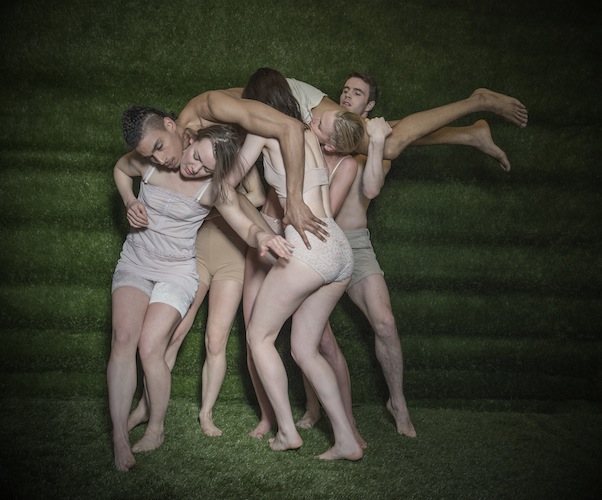Dance Review: Gallim Dance’s “WHALE” — Strictly Small Fry
Nothing in this lengthy work refers to whales, the ocean, or even the fishing industry.
Gallim Dance. Presented by World Music Crash/Arts at the Institute of Contemporary Art, Barbara Lee Family Foundation Theater, Boston, MA, February 10.

A scene from Gallim Dance’s WHALE. Photo: Nir Arieli
By Mary Paula Hunter
Gallim Dance’s production of WHALE, an evening length dance work choreographed by its director, Andrea Miller, puzzles on a number of levels. First, there is the title, which we are told her child suggested. Will this be a leviathan undertaking? Nothing in this lengthy work refers to whales, the ocean, or even the fishing industry. Dancers repeatedly shout “Romeo,” which suggested that unrequited love might be a theme, but it was never developed. Dancers spend a lot of their time running in circles, so the point of the entire performance is murky, to say the least. Oddly (and ironically) what seems to unify WHALE is its eschewal of certain choreographic techniques. It’s as if Miller built the work around what she won’t do.
Compositional coherence is one aversion. Instead of developed phrases, Miller shakes out grains of movement. She is not the first to explore this approach, but choreographers such as Merce Cunningham mastered a collage technique that made odd sense of the disparate. In his hands, the inorganic became organic. Miller’s movements are randomly collaged together, to the point that it becomes impossible to figure out what relationships were being hinted at through the freneticism — all the running, jumping, and shaking. The traditional compositional technique of theme and variation may be old school, but a laundry list is a poor substitute, particularly when it turns into the movement equivalent of babble. (Though in the right hands babble can be compelling.)
Second is a distaste for extended line, movement that is sustained rather than punched, retracted, or riddled with doubt. Dancers constantly stop in the midst of completing a movement, hobbling out of a turn that they no doubt could have executed with ease. An evening of faux amateurishness quickly becomes tedious. Interruptions to the jerky-jerkiness came along: there was a beautiful collapse of a dominoes line into a cairn, which then reassembled itself into the original line and then, via individual dancers peeling off, there came the creation of another pile.
Miller is not alone in today’s modern dance world in eschewing short, focused work. Ironically, she purports to being a disciple of the late, great Doris Humphrey, but Miller seems to have overlooked that artist’s dictum that every dance is too long. The kicker is that her attempts to extend the work often depended on the accomplishments of others. Miller’s choices were derivative of Pina Bausch, Kyle Abraham, and GAGA-inspired choreographers. Nudity, strobe lights, and an uninventive percussive score could not make up for the fact that this WHALE was bloated.
Mary Paula Hunter lives in Providence, RI. She’s the 2014 Pell Award Winner for service to the Arts in RI. She is a choreographer and a writer who creates and performs her own text-based movement pieces.
Tagged: Andrea Miller, CRASHarts, Gallim Dance, Mary Paula Hunter, WHALE

We’re writing to express our perception of Gallim Dance’s WHALE, which vastly differs from that of reviewer Mary Paula Hunter. She seems to ignore how WHALE choreographer Andrea Miller engages in direct conversation with the new generation of artists, thinkers, and enthusiasts. Our cultural zeitgeist embraces not just sex, love, and domesticity, but also sexuality, the psyche, inequality, trust, and collectivity—qualities which shone in Miller’s choreography and the dancers’ performances over and over again. We’ll also applaud the beautiful cohesion of movement vocabulary, light, and sound, as well as the moments of total enthrallment caused by imperfection, asymmetry, and reckless abandon. We believe WHALE and its poetics and aesthetics are one of the many adventurous, emotional performance works presented today which point to a more compassionate, playful civilization.
Hunter accuses Miller of a “faux-amateurishness” tack—not committing to whole ideas, developed phrases, compositional coherence. Hunter also states that the jerky and frenetic movement seems to jar her preference for smooth extended line. Though also personal preference, we were delighted by the authenticity found in Miller’s spastic, extreme athleticism: smooth, even aesthetic is no match for the messiness of love and attraction. Certainly those of us lucky to fall in and out of love have discovered that it is, in fact, often “punched, retracted, or riddled with doubt,” these qualities brilliantly mirrored in Miller’s movement vocabulary. Finally, to primarily laud the work based on the artistic predecessors whose influence is on view is also a disservice to this fine evening of dance. While certainly enamored with the Gaga-language, WHALE displays Miller’s unabashedly unique voice in the contemporary dance scene is both exciting and essential.
Kimberleigh A. Holman
Choreographer; Co-Artistic Director, Luminarium Dance
Adara Meyers
Playwright; Managing Director, Sleeping Weazel
Boston, MA
I wanted to thank Mary Hunter for her review of Gallim dance @ the ICA. She really helped clarify many of the issues I had with Whale and why I left the performance feeling puzzled, disappointed and irritated with the work. It did appear to be a work that was not entirely fleshed out & seemed haphazard in its ideas & execution. The nudity seemed gratuitous & irrelevant & much of the choreography appeared truncated & unfinished. I left feeling I had just seen a rehearsal rather than a finished work, more of a choreographic shrug than a finished piece of work. After all the hype, it was more than a little disappointing. O well. Guess I’m not part of the Zeitgeist.